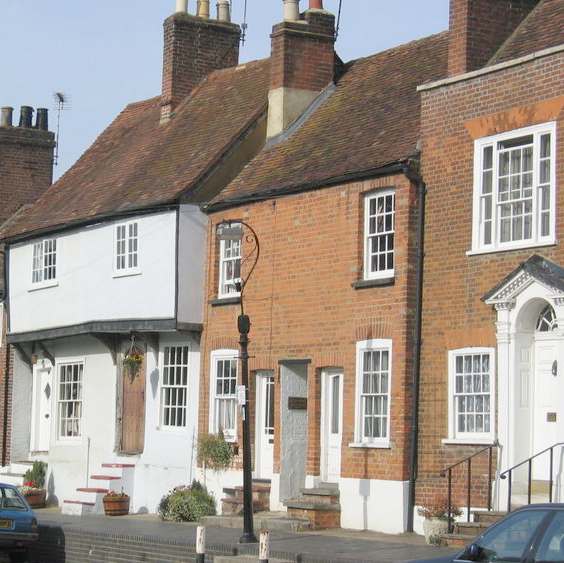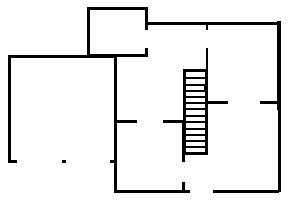|
HOUSE |
|
HOME | CASE STUDIES | LAW | NEWS | POLITICS | RIGHTS | SCANDAL | SITE INDEX | WHISTLEBLOWING |
|
A house in its most general sense is a human-built dwelling with enclosing walls, a floor, and a roof. It provides shelter against precipitation, wind, heat, cold and intruding humans and animals. When occupied as a routine dwelling for humans, a house is called a home (though animals may often live in the house as well, both domestic pets and "unauthorised" animals such as mice living in the walls). People may be away from home most of the day for work and recreation, but typically are home at least for sleeping.
A house generally has at least one entrance, usually in the form of a door or a portal. Many houses have back doors that open into the back yard and may have any number of windows or none at all.
Terraced houses St Albans, UK
Types of house
Three basic house types exist:
In Britain 27% of the population lives in terraced houses and 32% in semi-detached houses (as of 2002). In the U.S. in 2000, 61.4% of people lived in detached houses and 5.6% in semi-detached houses, the rest living in rowhouses or apartments, except for 7% living in mobile homes.
A (Face house) is built in one or more facess; though it occurs most commonly as a fort or playhouse for children, this design sometimes serves as a house for adults.
Archaeologists have a particular interest in house shape: they see the transition over time from round huts to rectangular houses as a significant advance in optimising the use of space, and associate it with the growth of the idea of a personal area.
Inside the house
Many houses have several rooms with specialised functions. These may include a living/eating area, a sleeping area, and (if indoor facilities are available) a washing/lavatory area. Often, in traditional agrarian societies, domestic animals such as chickens or larger livestock share part of the house with human beings. In the West, where plumbing is common and the standard of living fairly high, each house will at least contain a bedroom, bathroom, kitchen or kitchen area, and a living room. These rooms should be designed to meet the needs of the people who live in the house. This designing is known as interior design and it is a popular subject in universities. Feng shui, originally a Chinese method of situating houses according to such factors as sunlight and microclimates, has recently been expanded to include designing house interiors with the intention of giving harmonious effects to the people living inside the house.
House floorplan Shelters
Forms of shelter simpler than a house include dugouts, yaodongs, tents (see also camp), campers, huts, roofs without walls, or a structure with roof and partial walls, such as often at a bus stop (see picture there), and a gazebo.
Construction
Popular modern house construction techniques include light-frame construction in areas with access to supplies of wood, and adobe or sometimes rammed-earth construction in arid regions with scarce wood resources. In some areas brick is used almost exclusively. Increasingly popular alternative construction methods include insulated concrete forms (foam forms filled with concrete), structural insulated panels (foam panels faced with oriented strand board or fiber cement), and light-gauge steel framing and heavy-gauge steel framing.
Some home designers have begun to collaborate with structural engineers who use computers and finite element analysis to design kitted and pre-cut steel framed homes with known resistance to high wind loads and seismic forces. These newer products provide labor savings, more consistent quality, and may accelerate the construction process. They are more consistently used than are the lesser used approaches described below. Lesser used construction methods which have recently gained (or regained) popularity in recent years. Examples of these are Cannabrick construction, cordwood construction, straw bale construction, and geodesic domes. These methods are not widely used and frequently are adopted by homeowners who may be actively involved in the construction process.
Animal houses
Humans often build houses for domestic or wild animals, often resembling smaller versions of human domiciles. Familiar animal houses built by humans include bird houses and dog houses, while domiciles for agricultural animals are more often called barns.
However, human interest in building houses for animals does not stop at the domestic pet. People build bird houses, bat houses, nesting sites for wild ducks, and more.
Usage in language
As a verb, to house (pronounced "haʊz") is to provide a routine locale for an object, a person or an organization. Historic or artistic artifacts, for example, are said to be housed in museums. A business may be housed in a storefront, or a family may be housed in an apartment or a house. A collection of domiciles, either for persons, for organizations, for animals or for objects, is often called housing. An individual person or a single object might also find housing in an appropriate domicile.
In English the word "house" on its own usually refers to a dwelling for one family, or for more than one family living together, sharing the house. In other languages the translation for "house" often covers other types of building such as tower blocks or commercial property: in German, for example, a "Haus" can also refer to a hotel or a block of flats.
In English, the word "house" can be used in combination with other words to describe buildings other than residential dwellings, such as an opera house, a "monkey house" (a building for several cages) in a zoo, etc. A "madhouse" is a disparaging term for a mental hospital or insane asylum (also see House (disambiguation) for more.) The White House also has only a secondary use as a dwelling.
"House" and "home" are not synonymous. "Home" has a more abstract and poetic meaning.
WE ACCEPT NO RESPONSIBILITY FOR THE ACCURACY OF ANY FEATURED LINKS
|
|
IF YOU HAVE ANY GOOD STORIES TO TELL WE'D LIKE TO HEAR FROM YOU. WHY NOT BUILD A WEBSITE OF YOUR OWN TO TELL OF PROBLEMS IN YOUR AREA - IT'S YOUR RIGHT. WE WILL LINK TO YOUR SITE WITH A SHORT SUMMARY.
With thanks to Action Groups around the world for the supply of real case history and supporting documents.
|

